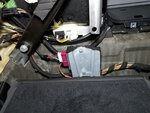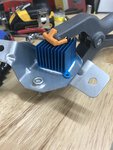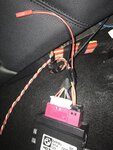I wanted to share the passive cooling modifications on my EKPM2. This should work for the EKPM3 as well. I have an 2007 E90, so if your chassis is different your EKP might mount in a different location and you might need a different solution. In the case of Filippo's E89 it looks like the EKP mounts directly to the chassis instead of a separate bracket. In this case maybe just changing the pad internally and adding one between the EKP and chassis would be a solution. In the E90 the EKP is mounted to a separate bracket that is not all that large and is not effective at conducting the heat to the chassis. See below
E90 EKP Mounting:
I bought a new gap pad and heat sink from Digikey:
Order today, ships today. TG-A1660-40-40-0.5 – Thermal Pad Gray 40.00mm x 40.00mm Square from t-Global Technology. Pricing and Availability on millions of electronic components from Digi-Key Electronics.

www.digikey.com
Order today, ships today. ATS-CPX040040030-157-C1-R0 – Heat Sink Assorted (BGA, LGA, CPU, ASIC...) Aluminum Top Mount from Advanced Thermal Solutions Inc.. Pricing and Availability on millions of electronic components from Digi-Key Electronics.

www.digikey.com
I installed the new gap pad in place of the old pad. I couldn't find a single piece big enough at this thermal conductivity, so I used two pieces next to each other. Don't over tighten the PCB mounting screws. It would probably be a good idea to use lock tight and get then snug, but not so tight the gap pad material is squeezed out. It is fairly soft. You can make out the ends of the heat sink mounting screws in the picture - there are two. Make sure they are not long enough to touch the board and cause a short.
NOTE: IT IS IMPERATIVE THAT THE PAD USED ON THE INSIDE OF THE EKP BE NON-CONDUCTIVE. GRAPHITE IS A NEW MATERIAL BEING USED AS A THERMAL INTERFACE BUT IT CONDUCTS ELECTRICITY. DO NOT USE A CONDUCTIVE PAD INSIDE THE EKP! CHOSE A SILICONE BASED PAD INSTEAD.
I trimmed the original mounting ears from the heat sink so when I cut a hole in the EKP mounting plate (not pictured) there was still enough material to keep it rigid. I removed part of the outside fins to make new holes. I tapped the back plate of the EKP. It is thin in some spots so be careful tapping and tightening the screws. I cut a hole in my mounting plate to accommodate the heat sink. You can't see it, but I put thermal paste between the EKP back plate and the heat sink.
With the EKP mounted I noticed the heat sink was close to a bundle of wires. I covered that bundle with spiral wrap to prevent wearing a hole in the wire insulation. It doesn't touch the heat sink, but with vibration I just wanted to be sure. The heat sink should be oriented so the fins are vertical. This will allow convection to pull heat away from the heat sink.
Unfortunately I don't have any before and after data, but I don't think it is unreasonable to say changing the thermal pad and adding the heatsink is a step in the right direction. The parts are cheap and it didn't that all that long to do this.
Let me know what you think.
[EDIT]
I want to add that it is not necessary to mount the heat sink directly to the module base plate as I have done, it could also be mounted to the bottom of the mounting bracket as well. That way you don't need to cut a hole in the bracket. If you go this route you need additional gap pads between the module and the bracket (the entire surface if possible) and be sure to put some thermal interface material (gap pad, thermal paste) between the bracket and the heat sink. Thermal epoxy might be best because if you screw the heat sink to the bracket, those screws could interfere with the EKP mounting flat to the bracket unless you find a heat sink that allows the mounting screws to attach to the ears with the studs for mounting the EKP. You want the EKP and bracket to touch with the flatest, largest surface area possible for the best heat flow.
The most efficient thermal path will be to mount the heat sink directly to the EKP base plate, but mounting it to the bracket is better than nothing.
Leaving a heat sink out completely and just changing the gap pad inside the module and placing a gap pad between the module and the bracket will be the least effective passive cooling method, but will probably be considerably better than stock.
Another option is to place an aluminum bar or sheet (1/8" thick or so) between the EKP and the bracket. Put a gap pad between the EKP and the added piece of aluminum (and don't forget the pad internal to the EKP!). Then you can make the bar or sheet as large as is practical. This is what I suggested in the case of the E93 below. The method should be very effective because it is essential the same as mounting a heat sink directly to the EKP base plate. Home Depot sells 1/8 x 2" aluminum bar so it should be easy to get.
McMaster-Carr sells everything if you want more options.
You can think of heat flow like an electric circuit. Every material and interface has a resistance. You want to minimize those resistances to maximum flow (electric current or heat). You can choose materials with higher thermal conductivity (copper, aluminum) and interfaces can have
thermal interface material added (thermal paste, gap pad). The shortest path with the fewest interfaces is best. To minimize the resistance to heat flow from a material to the air (ambient environment), increase the surface area. This is why heat sinks have fins.
. I'll also note that I'm planning to move to the Walbro 535LPH F90000295, which @martymil has been vetting out successfully. If you have not seen this, @ajm8127 , you may find it interesting: https://www.spoolstreet.com/threads/ti-automotive-walbro-274-vs-285-vs-295.5882/post-95536




